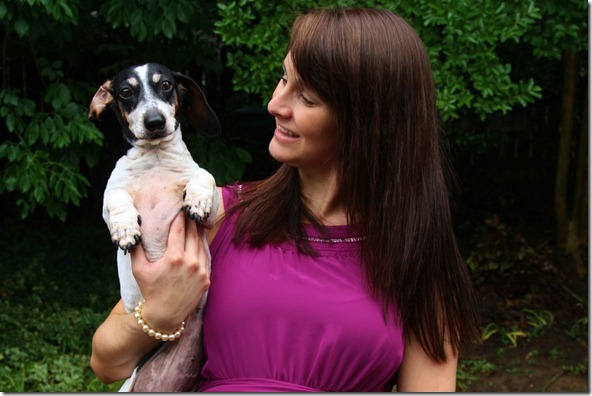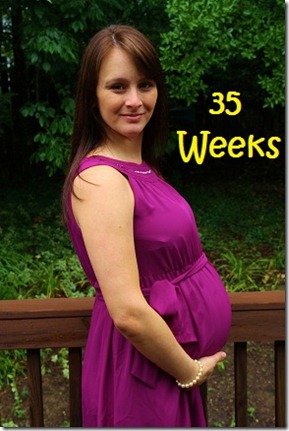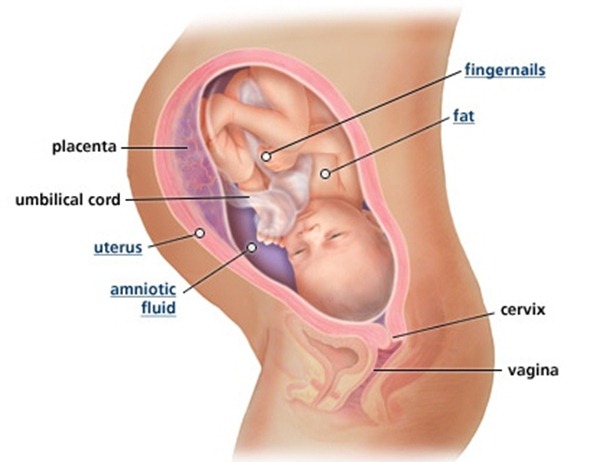Thoughts on the cord… and not the invisible one that attaches me to my dogs
I know that some of you think I give Maggie a hard time – always teasing her on the blog for being a few crayons short of a full pack – but I love her so much. In five weeks or so, her world is gonna be rocked by the new baby (um, if she even notices that there is a new baby in our midst… she really might not). I hope she adjusts well; I know James will be fine. I’ve been giving her lots of extra kisses lately just in case.
On that note… Happy 35 Weeks, BabyHTP! Here’s what you are up to this week – besides causing all sorts of weird pregnancy symptoms: “Your baby doesn’t have much room to maneuver now that he’s over 18 inches long and tips the scales at 5.25 pounds. His kidneys are fully developed now, and his liver can process some waste products. Most of his basic physical development is now complete — he’ll spend the next few weeks putting on weight.†(Source) I read that the baby’s body fat percentage is currently 15% and will bulk up to 30% before birth. Neat!
All in all, I feel pretty good for nearly 9 months pregnant. I’m sleeping well, movin’ my body at least three times a week (lots of walking and swimming), and trying to eat healthy. A huge part of me just wants to meet the baby already – I wish I could accelerate time! The biggest question on my mind is definitely BOY OR GIRL? BOY OR GIRL? It keeps me up at night!
What do you guys think? Boy or girl? Our families think it’s a boy (my mom is voting girl). Most of my friends say girl, though.
(People have been asking about my maternity clothes – I’ve gotten everything at Destination Maternity – in the budget mom section – and Target. I’ve bought about a week and a half’s worth of pieces, and it works well; I own 7 tops, 1 pair of jeans, 1 pair of dress pants, and 4 dresses; the dresses were all recent gifts.)
So – this week, I thought it would be interesting to discuss our plans for the cord. The cord – what connects the baby to the placenta – isn’t usually given much thought. It’s simply clamped and cut. But like most things relating to pregnancy, we’ve been doing a ton of research to decide if we want to go about things in a slightly different way than the traditional medical model.
(Source – I thought I’d spare you of a real-life cord pic, although I think it’s pretty cool.)
So, when the baby comes out, the cord is connected between the baby and the placenta, which is still inside the mom (I’ve been told that the placenta is normally delivered within an hour after birth). Under normal circumstances in a hospital birth, the cord is clamped within a minute of delivery; in some areas, such as Mexico City, it occurs within 17 seconds of birth on average (Source). Once it’s clamped, it cannot be ‘unclamped.’ The act of clamping cuts off the exchange of blood between the placenta and baby; the cord is then cut.
However, as I understand things, there are several different options for dealing with the cord.
-
First, you can delay the cord clamping. Why would you want to do this? For one, delaying clamping for at least 2 minutes reduces the baby’s risk of anemia because more iron is transferred from the placenta to the baby (Source; Source). This benefit has been shown to last for as long as the first four months of a baby’s life – with iron concentrations that are up to 45% higher (Source). Some people worry that there are risks relating to delayed cord clamping, such as jaundice, but several studies have failed to find a link. A delay in clamping can also provide the baby with the equivalent of 21% of the infant’s final blood volume – woah! (Source) Some professionals advise waiting to clamp the cord until a certain moment in time – generally 2 – 3 minutes – but others recommend waiting until the cord stops throbbing or pulsating.
-
Second, you can skip clamping and cutting entirely. This is called a ‘lotus birth.’ In this case, the cord is allowed to naturally break off (it can take around three days); the mother wraps the placenta up in a towel and carries it with the baby until this point. The placenta may be treated with special herbs as well.
-
And lastly, you can privately bank the baby’s cord blood (edited to add: you can also bank the cord blood for public use). The blood in the cord is a rich source of stem cells, which can be frozen and stored for later use – for example, if the child develops leukemia or a host of other diseases. When you’re pregnant, you’re hit with advertisements for cord blood banking right and left – cord blood banking is a huge business because it is very expensive to do. However, the practice is extremely controversial, as it requires very early clamping of the cord. In fact, the American Academy of Pediatrics discourages cord blood banking for self-use (there are public banks as well); many other associations have expressed issues with the private cord blood banking industry. The likelihood of a healthy, low-risk child needing their own cord blood is estimated to be 1 in 20,000; furthermore, they may not even be able to use their own cells for a variety of reasons. (Source)
For me, the choice was clear. I’m not going to carry around my placenta for three days (although I am going to eat it…), and I’m not going to pay thousands of dollars for the off chance my child will need stem cells, especially since cord blood banking is an all-or-nothing thing (you can’t delay clamping to give the child immediate benefits and still bank). So, we’re going to delay clamping until the cord stops pulsating.
The only problem? Although there is a growing amount of research that delaying clamping is very beneficial to the health of the baby, many hospitals still practice early clamping. As far as I can tell, the main reason for early clamping is that it is procedure. Baby comes out, clamp goes on; at many hospitals, the birth team simply goes into automatic mode. We have been told that we need to be really on top of the birth team (in a nice way, of course) to ensure early clamping does not occur because it happens so swiftly (our request is also written into our birth plan). I think one of the Husband’s biggest challenges at birth is to not get caught up in the excitement of the moment and forget to remind the birth team that we don’t want early clamping. The Husband will ask them to delay clamping, and after several minutes, he will verify that the pulsating has stopped by feeling the cord with his fingers.
I do feel like I end up questioning something at every point in this journey. I’m usually not really comfortable just doing what is ‘done;’ I want to know why I should do it. If you can give me a good reason, great! I’ll do it! But I need to know why, and I have a feeling that won’t stop when the baby is here. Very often, like so many things in life, the answer to my ‘why’ doesn’t seem crystal clear. I’ve found that, with pregnancy and birth, the choice of whether to participate in many procedures comes with an equal amount of benefits and drawbacks. Honestly, it is very hard to make most of these parenting decisions for both the Husband and I. Should I get this test? Should I take this supplement or that one? Should I get this shot? Should I allow them to bathe the baby immediately? What should I do in this scenario or that one? All in all, I’m pretty good at having a panic-free pregnancy but, like I said, making all these decisions is very challenging! The cord debate was a nice one to research because, for our family, the answer did seem obvious – for once! Delaying clamping seems like a small and easy request that can potentially make a big difference in the health of our child.
Your turn – I’d love to hear your thoughts on clamping. I’d also love to hear your thoughts on making tough parenting decisions. Do the options and different opinions drive you crazy or do you like doing research? What decisions were easy and which were hard? This varies, I’m sure, so much from person to person!







I love how well you research everything! They clamped ours immediately, but I donated the cord blood for both. I hope that my donation helped others or went towards good research.